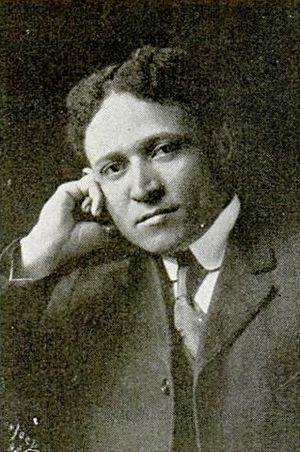William Sidney Pittman facts for kids
Quick facts for kids
William Sidney Pittman
|
|
|---|---|

W. Sidney Pittman, ca 1916
|
|
| Born | April 21, 1875 |
| Died | 14 March 1958 (aged 82) |
| Occupation | Architect |
William Sidney Pittman (born April 21, 1875 – died March 14, 1958) was an important American architect. He designed many famous buildings. For example, he designed the Zion Baptist Church in Washington, D.C. He was also the son-in-law of the famous leader, Booker T. Washington.
Contents
Early Life and Education
William Sidney Pittman was born in Montgomery, Alabama, on April 21, 1875. His mother was a laundress who had been a slave. His father was a prominent white man in the city.
When he was 17, Pittman went to Tuskegee Institute. There, he studied woodwork and architectural drawing. He finished these programs in 1897. He then won a scholarship to attend the Drexel Institute in Philadelphia. This was a school mainly for white students at the time. He completed a five-year architecture program in just three years, graduating in 1900. After college, he returned to Tuskegee to teach for five years.
Building a Career
Pittman designed several buildings for the Tuskegee Institute. One of these was the Collis P. Huntington Memorial Building, built between 1900 and 1905. Later, he moved to Washington, D.C. There, he started his own successful architecture business. He received many important jobs.
He helped create the Fairmount Heights housing development. This was a community for Black families in Maryland. In 1907, he married Portia Washington. She was the daughter of the famous leader, Booker T. Washington. The home Pittman designed for his family in Fairmount Heights is still an important landmark today.
Pittman also won a big project from the government. He designed the Negro Building for the Tercentennial Exposition in Jamestown, Virginia, in 1907. In 1913, he designed the Colored Carnegie Library of Houston. This was the only library available for African Americans in Houston at that time.
Moving to Texas
In 1913, Pittman moved to Texas. He wanted to be more independent from his famous father-in-law. In Texas, he continued to design many important buildings.
Some of his notable works in Texas include:
- The Pythian Temple (1915–1916) in Dallas.
- The St. James African Methodist Episcopal Church (1920) in Dallas.
- The Allen Chapel A.M.E. Church (1914) in Fort Worth.
- The Joshua Chapel A.M.E. Church (1917) in Waxahachie.
- The Wesley Chapel A.M.E. (1926) in Houston.
Later Life and Legacy
After raising three children, Pittman and his wife, Portia Washington Pittman, separated in 1928. She returned to teach in Tuskegee. Pittman stopped working as an architect for a while. He worked as a skilled carpenter instead.
For nearly 20 years, he published a weekly newspaper called The Brotherhood Eyes. This paper shared different opinions within the African-American community. It was an alternative to other newspapers like the Dallas Weekly or the Dallas Express. In his paper, he often criticized local preachers and other Black leaders. This made him many enemies.
William Sidney Pittman died on March 14, 1958, in Dallas, Texas. He is buried in Glen Oaks Cemetery. His buildings are an important part of American history and architecture.
Images for kids





